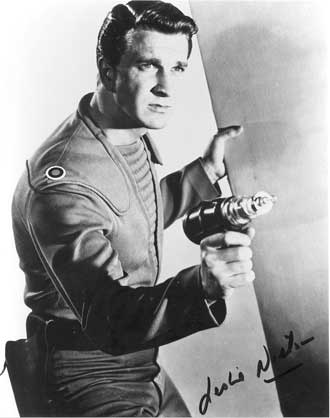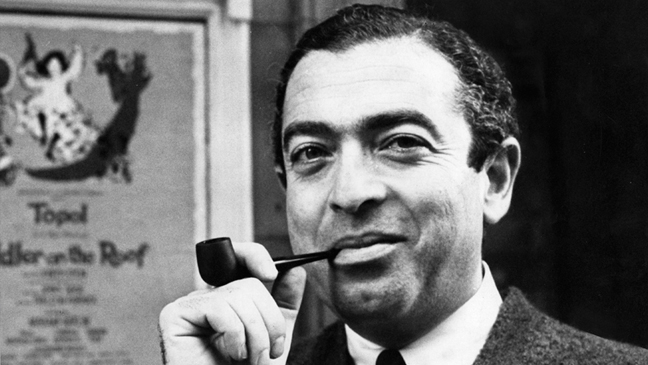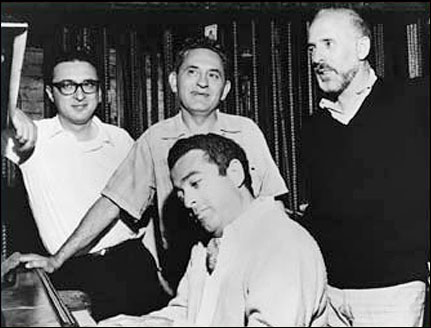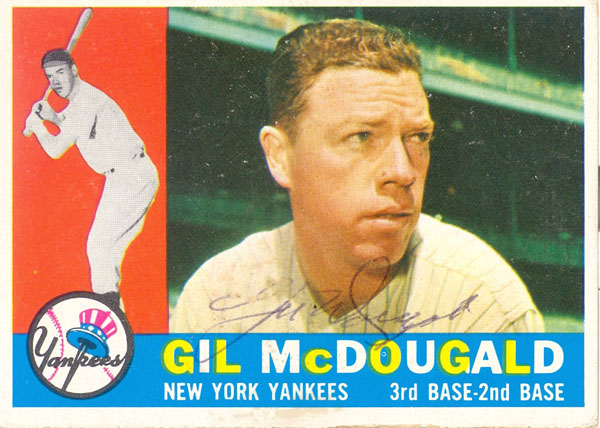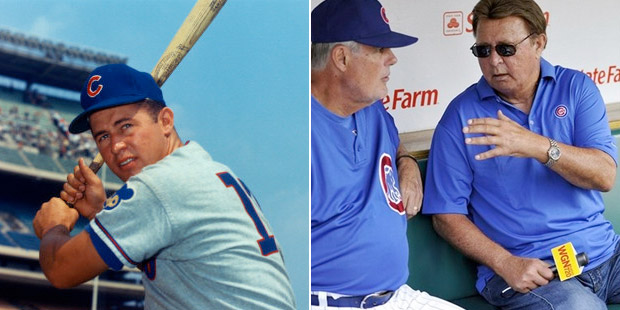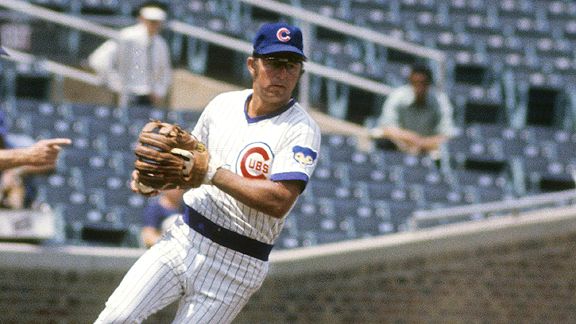Crossing Over
Leslie Nielsen in Forbidden Planet (1956)‘Don’t Call Me Shirley’
Leslie Nielsen
February 11, 1926-November 28, 2010It is perhaps the supreme irony of Leslie Nielsen’s long and productive acting career that he became so wildly popular a comic actor that when folks saw him in re-runs of any of the outstanding dramatic roles he played in the ‘50s and ‘60s on shows such as Alfred Hitchcock Presents and The Virginian, laughter inevitably ensued from his first appearance on screen. Nothing was every the same for Nielsen after he was cast as Dr. Barry Rumack in the Zucker-Zucker-Abrahams 1980 disaster film spoof Airplane! “Surely you can’t be serious,” sputtered Robert Hays’s Ted Striker when the physician asked if Striker, a psychologically damaged war pilot, could fly the faltering plane. To which Rumack/Nielsen responded: “I am serious. And don’t call me Shirley.” Right now, somewhere in the world, someone is saying, “Don’t call me Shirley.” Nielsen, who told the Vancouver Sun in 2007 that he was “pleased and honored to have delivered that line,” conceded feeling that the line was amusing, but “it never occurred to me that it was going to become a trademark.” In its listing of the top 100 movie quotes, the American Film Institute ranked “Don’t call me Shirley” at #79, following “Open the pod doors, HAL,” from Stanley Kubrick’s 2001: A Space Odyssey and ahead of “Yo, Adrian!” from Rocky.
‘Don’t call me Shirley’—Leslie Nielsen and Robert Hays in the classic scene from Airplane!Nielsen’s new career as a deadpan comic actor didn’t exactly take off with Airplane!’s success. The Zuckers and Abrahams next tried their hand at TV satire, casting Nielsen as hapless detective Frank Drebin in Police Squad!, a show styled after Quinn Martin’s dramatic police dramas such as Cannon and Barnaby Jones, whose stars were wily, tenacious, indefatigable investigators who always got the bad guys, whereas Frank Drebin was equally likely to trip over his own feet and answer in non-sequitors as he was ever to solve a case. The show lasted only six episodes, after which Nielsen returned to movies, appearing in the cheapo horror films Prom Night (1980) and Creepshow (1982). The Zuckers and Abrahams were not finished with Nielsen, though, and cast him in a feature-length version of a Police Squad!-style story, 1988’s The Naked Gun: From the Files of Police Squad! What didn’t work on the small screen worked marvelously on the big screen, as the bumbling, fumbling Drebin obliviously made his way towards deep-sixing a drug kingpin’s plan to assassinate Queen Elizabeth II. A huge winner at the box office (to the tune of $78 million) and a critical favorite as well, The Naked Gun spawned an even more successful sequel, The Naked Gun 2 ½: The Smell of Fear (almost $87 million in box office receipts) and a less well received third installment, Naked Gun 33 1/3: The Final Insult ($51 million).
After The Naked Gun series had run its course, it became Nielsen’s career albatross, as he was cast as Drebin-style characters in one mediocre comedy after another. A supporting role in 2003’s Scary Movie 3 and its Scary Movie 4 sequel finally vaulted him to box office success again. In his later years he returned to dramatic roles, winning acclaim for his portrait of Clarence Darrow in Darrow, a one-man theater show, and as a doctor in a Discovery Channel education show with a humorous twist, Doctor’Ology. In 2008 he was reunited with David Zucker in a holiday spoof, An American Carol. His older brother, Erik Nielsen, is a former Deputy Prime Minister of Canada who was the subject of a 1985 HBO mock documentary, The Canadian Conspiracy, in which Leslie appeared along with other prominent Canadian media types. At the time of his death from pneumonia on November 28, at age 81, his resume showed him appearing in more than 100 films and more than 1,500 television shows. Married four times, Nielsen is survived by his fourth wife, Barbaree Earl, and two children from his second marriage, Maura and Thea Nielsen. He has a star on the Hollywood Walk Of Fame, has been inducted into Canada’s Walk of Fame, and in 2002 was named an honorary citizen of West Virginia (Nielsen was a naturalized U.S. citizen) and an “Ambassador of Mountain State Goodwill.” In 2003 Grant McEwan University in Edmonton, Alberta, Canada, named its school of communications after him. They were serious.
***
‘If I Were a Rich Man…’
Jerry Bock
November 23, 1928-November 3, 2010
American musical theater composer Jerry Bock, a Tony Award and Pulitzer Prize winner with his partner Sheldon Harnick for their 1959 musical Fiorello! And a Tony winner as Best Composer and Lyricist for the 1964 musical Fiddler On the Roof, with Harnick, died of heart failure on November 3. He was 81. His death followed by 10 days that of Joseph Stein, who wrote the book for Fiddler and at whose memorial service Bock had spoken.
Before meeting Harnick (a Chicago native who had been a dance band violinist before moving to New York, where his songs had been performed in revues such as New Faces of 1952 [“Boston Beguine”] and Shoestring Revue), Bock had worked in the theater with lyricist Larry Holofcenter, first contributing some songs to a theatrical revue, Catch a Star, and then providing the score for the Sammy Davis Jr. vehicle, Mr. Wonderful, a 1956 production that ran for 383 performances. Both the title song and “Too Close for Comfort” became standards. But it was in teaming with Harnick that Bock’s career too off—even their first effort together, a box office bomb called The Body Beautiful, paid dividends when it caught the attention of producers George Abbott and Harold Prince, who asked the team to work on a new musical about the former mayor of New York, Fiorello H. LaGuardia. Opening in 1959, Fiorello! ran for 795 performances.
(from left) Sheldon Harnick, Joseph Stein, Jerry Bock and Jerome RobbinsNext came the underrated Tenderloin (1960), a humorous exposé of vice in New York with some good songs including "Little Old New York," "The Picture of Happiness" and "How the Money Changes Hands." In 1963 the team wrote several numbers for the critically acclaimed marionette show Man in the Moon, and later in the same year, came up with what is considered to be their best score, for She Loves Me. Despite its delightful songs—such as "Will He Like Me?", "Ice Cream," "A Trip to the Library" and "She Loves Me"—plus Broadway's favorite ingénue, Barbara Cook, She Loves Me closed after 302 performances. Bock and Harnick's next show clocked up more than 10 times that total in New York, and was a smash hit around the world. Fiddler on the Roof (1964), starring Zero Mostel, became one of the most cherished of all Broadway musicals, and gave the world of popular music (and Jewish functions of all kinds) hit songs such as "Matchmaker, Matchmaker," "Sunrise, Sunset," and the immortal "If I Was a Rich Man." It proved impossible to follow, and for the remainder of the decade the composers worked on a variety of projects, including a Sherlock Holmes musical, Baker Street, The Apple Tree, which was based on stories by Mark Twain and others and ran for 463 performances, and Her First Roman, based on George Bernard Shaw's play Caesar and Cleopatra, to which they contributed a few songs. After The Rothschilds (1970), with a book by Sherman Yellen, based on Frederic Morton’s biography of the powerful banking family. With a strong cast headed by Hal Linden, Jill Clayburgh and Paul Hecht, The Rothschilds survived lukewarm reviews and ran for 505 performances. It success, however, contributed to the undoing of the Bock-Harnick partnership, as the two had a bitter disagreement over whether director Derek Golby was sufficiently experienced to steer the show and should be replaced by Michael Kidd.
According to Robert Berkvist’s obituary of Bock published in the New York Times, Harnick finally spoke about the breakup in 2004, saying “We had severe artistic differences. I felt, as many on the staff did, that the director should be fired. Bock was a big defender of him. He was fired, and there was a very big strain between Jerry and I.”
After The Rothschilds, Bock left Broadway for good. He wrote his own lyrics for other new shows, including a well-received series of musicals for young audiences between 2000 and 2007, and music for a feature film (Sidney Lumet's A Stranger Among Us, 1992). He also worked on personal, private songwriting projects during the last four decades, yielding autobiographical song cycles (Album Leaves, Trading Places) and thematic collections (Noblesse O' Blues, Three/Four All).
She Loves Me, music and lyrics by Jerry Bock and Sheldon Harnick: a video scrapbook of the Broadway musical that opened on April 23, 1963 and starred Barbara Cook, Daniel Massey, Barbara Baxley, Ludwig Donath and Jack Cassidy.In Memoriam: Composer Jerry Bock
‘I simply could not stop the brood of melodies and harmonies that waited to be born’
By Philip Lambert(Excerpt from Oxford University Press USA November 5, 2010 at Oxford University Press USA)
Jerry Bock was the master of what Lehman Engel called the "musical costume." He could dress up a song in any style, from the nineteenth-century parlor song (for Tenderloin) to the jazz shouter (in The Apple Tree). He would immerse himself in the style and culture of the story he was helping to tell and then transport the audience there with musical references and flavorings. In She Loves Me he took us to Hungary, in The Rothschilds to the power centers of eighteenth-century Europe. In his most successful show, Fiddler on the Roof, he drew from his own background and heritage to evoke a turn-of-the-century Russian shtetl. Of that experience, he said in 2008, "I simply could not stop the brood of melodies and harmonies that waited to be born."
Zero Mostel, ‘If I Were a Rich Man,’ from Fiddler On the RoofThere was, in other words, no single Jerry Bock "style." His style was simply an acute sensitivity to the dramatic requirements of the project at hand. He and Harnick would work tirelessly on each of their scores searching for perfect dramatic support, during development, rehearsals, and pre-Broadway tours, usually producing two or three times the number of songs a show required. They became generous, energetic collaborators, willing to do whatever was necessary to make a show better. Their proverbial trunks are filled with superior efforts that had to be set aside out of respect to dramatic needs, like "Where Do I Go From Here?" (Fiorello!), "Tell Me I Look Nice" (She Loves Me), and "When Messiah Comes" (Fiddler). Some of their most enduring creations, like "Little Tin Box" (Fiorello!), "Do You Love Me?" (Fiddler on the Roof), and "In My Own Lifetime" (The Rothschilds), were written on the road, in response to dramatic requirements they had sensed on a pre-Broadway stage.
No matter the circumstances of a show's development, Bock's scores display remarkable consistency and cohesion. In Fiorello! and Tenderloin he adopted clichés of period songs in multiple ways, overt and subtle. In She Loves Me he used little ideas from Hungarian music to flavor songs of disparate styles. A recurring musical motif in Fiddler is adapted and transformed in tandem with the development of the story. In 1970 Bock wrote a note to his orchestrator for The Rothschilds, Don Walker, in which he laid out his constructive plans for the show, telling a musical story of triumph over oppression to support the one on stage. He was a true craftsman, in the grand tradition of the most thoughtful, innovative minds on Broadway—Leonard Bernstein, Frank Loesser, and Bock's contemporary Stephen Sondheim.
‘Sunrise, Sunset,’ from Fiddler On the Roof, 1971 film adaption directed by Norman Jewison and starring Topol as Tevye. The film won three Academy Awards, for Best Picture, Best Actor (Topol) and Best Supporting Actor (Leonard Fry, as Motel the Tailor)He was also one of the last to extend the traditions of Rodgers and Hammerstein on the Broadway stage. Rather than taking the musical in some new artistic direction, as Sondheim did, Bock showed how sturdy and venerable the old traditions were, and how eloquently they could survive in the hands of expert practitioners. The musicals of Bock and Harnick, particularly She Loves Me and Fiddler on the Roof, represent the last great pillars in an edifice that Rodgers and Hammerstein had begun to erect in the 1940s, what some have called the "golden era" of the Broadway musical. Bock once fondly remembered an article from the Daily News in 1955, about his Broadway debut in Catch a Star!, in which Richard Rodgers was quoted expressing particular affection for a song by Bock. This, said Bock in 2008, was a "most treasured moment" in his early career. The torch had been passed.
Philip Lambert is author of the forthcoming book To Broadway, To Life!—The Musical Theater of Bock and Harnick, as well as Inside the Music of Brian Wilson and The Music of Charles Ives. He is Professor of Music at Baruch College and the Graduate Center, City University of New York.
***
Gil McDougald
May 19, 1928-November 28, 2010Ron Santo
February 25, 1940-December 2, 2010
Playing on championship teams with high-powered stars such as Mickey Mantle, Yogi Berra and Whitey Ford, GIL MCDOUGALD did not attain legendary stature in his 10 seasons as a Yankee, but he did his job and he did it well, season after season, steady at the plate, reliable at multiple infield positions and, by all accounts, a genial presence in the locker room. The San Francisco native was the American League Rookie of the Year in 1951, holding down third and second base and hitting .306. In the World Series his grand glam—the first Series grand slam by a rookie—propelled the Yankees to a Game 5 win. In his Yankee career McDougald was a five-time All-Star. Blessed with lightning-quick reactions to go along with his unerring fielding, he helped preserve Don Larsen’s perfect game performance in the 1956 World Series when, playing shortstop, he threw out the fleet Jackie Robinson after retrieving a line drive that had deflected off third baseman Andy Carey.
New York Yankees Phil Rizzuto, Gil McDougald, Whitey Ford and Yogi Berry masquerade as southern gentlemen on The Phil Silvers Show, 1956, with Dick Van Dyke playing a hillbilly rube on the fast track to baseball stardom, if he can be convinced to sign with a team called Yankees. Legendary broadcaster Red Barber also makes an appearance.Unfortunately, McDougald’s place in the baseball history books is marked mostly by a single fateful at-bat on May 7, 1957 at Cleveland’s Municipal Stadium. Hitting against the overpowering southpaw fireballer Herb Score, McDougald smashed a hard line drive that struck the pitcher in the face. Score crumpled to the ground and was carried off with a severe injury to his right eye and a broken nose. Then in his third season, Score was sidelined for the remainder of the ’57 campaign, but developed arm trouble after his return and never regained the form that once had many predicting a Hall of Fame career for him. A shaken McDougald told reporters, “If Herb loses the sight in his eye, I’m going to quit the game,” and admitted the sight of Score collapsed on the field made him “sick to my stomach.” He stayed in contact with Score not only through the pitcher’s rehabilitation, but for the remainder of their lives. (Score died on November 11, 2008.)
A lesser-known line drive, off the bat of his Yankees teammate Bob Cerv, had struck McDougald two years before his felled Score. Cerv’s drive struck McDougald in the ear as he was standing near second base. He missed only a few games, but the blow damaged his hearing. By 1980 he was almost totally deaf, a fact he did not reveal publicly until 1994 in an interview with the New York Times’s Ira Berkow. Contacted by physicians who had read the article, McDougal underwent a cochlear implant surgical procedure in November 1994 that restored his hearing. In his remaining years, he worked to raise awareness of technology to aid the hearing impaired, comparing the thrill of seeing progress in this field, “particularly with little children,” to be like “hitting a home run with the bases loaded.”
McDougald retired in 1960 with a career batting average of .276, with two seasons above .300. He is survived by his wife, Lucille; his sons Tod, Gil Jr., Matthew and Jon; his daughters, Christine Flynn, Denise Costigan and Courtney Harmon; 14 grandchildren; and seven great-grandchildren.
‘Forever the Heart and Soul of Cubs Fans’
Ron Santo, as a Cub player, and as a Cubs broadcaster (with then-Cubs manager Lou Piniella)Signed as a free agent by the Chicago Cubs in 1959, making his debut on June 26, 1960, RON SANTO came to epitomize the franchise as much as his celebrated partner on the left side of the infield, “Mr. Cub” Ernie Banks. Unlike Banks, and unlike a later Cub legend, second baseman Ryne Sandberg, Santo has never earned enough votes to make the Hall of Fame. Ron Santo died on December 2 from complications of bladder cancer.
From the Wikipedia entry on Santo:
Santo was a nine-time National League All-Star, and led the league in walks four times, in on base percentage twice and in triples once. He hit for a .300 average and hit 30 home runs four times each, and is the only third baseman in major league history to post eight consecutive seasons with 90 RBI (1963-1970). The winner of five consecutive Gold Glove Awards for fielding excellence (1964-1968), he set or tied National League records by leading the league's third basemen in total chances eight times, in games, putouts and assists seven times each, and in double plays six times. From 1966 to 1974 he held the National League record for assists in a single season. He also set National League records for career assists (4,532), total chances (6,777) and double plays (389) at third base, all of which were eventually broken by Mike Schmidt between 1986 and 1988; his National League total of 2,102 games at third base fell 52 short of Eddie Mathews' league record, and he then ranked sixth in National League history in putouts (1,930) and ninth in fielding percentage (.954).
Santo led the league in double plays six times (1961, '64, '66-'68, '71), tying the major league record held by Heinie Groh; Schmidt also later tied this record. He led the National League in total chances every season from 1961 through 1968. He appeared at third base in every Cubs game from April 19, 1964 through May 31, 1966, establishing a league record with 364 consecutive games at the position; his 164 games at third base in 1965 remain the major league record.
He was the second player at his position to hit 300 career home runs, joining Eddie Mathews, and also ended his career ranking second to Mathews among third basemen in slugging average (.464) and third in runs batted in (1,331), total bases (3,779) and walks (1,108). Santo broke Mathews' National League record of 369 career double plays at third base in 1972, and in 1973 he broke Mathews' league records of 4,284 assists and 6,606 total chances. Schmidt passed Santo's record for double plays in 1986, his record for assists in 1987, and his mark for total chances in 1988. During his 14-season run with the Cubs, Santo hit 337 home runs, then the eighth most by a National League right-handed hitter; his 1,071 career walks with the Cubs remain the team record for a right-handed hitter. He was the first third baseman to hit 300 home runs and win five Gold Gloves, a feat since matched only by Schmidt.
Baseball’s statistical guru Bill James ranks Santo among the top 100 players of all time, and sixth among third basemen.
For his part, Santo remained remarkably sanguine about the Hall of Fame slight. When the Cubs retired his jersey number on September 28, 2003, he proclaimed to the packed house at Wrigley Field, “This is my Hall of Fame!”
Maybe Santo could be so blasé about his Hall of Fame fortunes because he had fought tougher battles most of his life, battles that no one knew about until 1971, when, on “Ron Santo Day” at Wrigley he revealed he had struggled with diabetes since being diagnosed as an 18-year-old. After learning he had the disease, Santo did his own research into its causes and progression and learned he might live another 25 years if he took care of himself. He feared if he told Cubs management about the diabetes he might be forced into retirement. One of his Cubs teammates, catcher Randy Hundley, said the players had no idea anything was afflicting Santo until one night in St. Louis when he made an errant throw to first base and sank down on one knee in pain. Santo later told his fellow Cubs he had been diagnosed with diabetes six years earlier. “We kidded him about it quite a bit,” Hundley said, “made his life miserable at times.” Eventually the diabetes took its toll, necessitating the amputation of his right leg in 2001 and the left in 2002. In 2004 his career and his battle against diabetes were the subject of a documentary, This Old Cub, written, directed and co-produced by his son, Jeff Santo.
Santo endorsed the Juvenile Diabetes Research Foundation’s annual Ron Santo Walk to Cure Diabetes in Chicago from 1974 until his death, and raised more than $60 million for the Juvenile Diabetes Foundation. In 2002, he was named the Juvenile Diabetes Research Foundation’s “Person of the Year.” His son’s film inspired 56-year-old schoolteacher Bill Holden to walk 2,100 miles from Arizona to Chicago in an effort to raise $250,000 for diabetes research. Holden began his walk on January 11, 2005, and arrived at Wrigley Field on July 1, in time to throw the game’s first pitch to Kerry Wood; during the seventh inning stretch, he and Santo sang a duet of “Take Me Out To The Ballgame.”
Ron Santo on living, playing with diabetesWanting to stay close to the game, Santo joined the Cubs’ WGN broadcast team in 1990 as a color commentator. “He absolutely loved the Cubs,” his broadcast partner Pat Hughes told the Chicago Tribune. “The Cubs have lost their biggest fan. He considered going to the game therapeutic. He enjoyed himself in the booth right to the end.”
Cubs Chairman Tom Ricketts released a statement: "My siblings and I first knew Ron Santo as fans, listening to him in the broadcast booth. We knew him for his passion, his loyalty, his great personal courage and his tremendous sense of humor. It was our great honor to get to know him personally in our first year as owners.
"Ronnie will forever be the heart and soul of Cubs fans."
Founder/Publisher/Editor: David McGee
Contributing Editors: Billy Altman, Laura Fissinger, Christopher Hill, Derk Richardson
Logo Design: John Mendelsohn (www.johnmendelsohn.com)
Website Design: Kieran McGee (www.kieranmcgee.com)
Staff Photographers: Audrey Harrod (Louisville, KY; www.flickr.com/audreyharrod), Alicia Zappier (New York)
E-mail: thebluegrassspecial@gmail.com
Mailing Address: David McGee, 201 W. 85 St.—5B, New York, NY 10024


